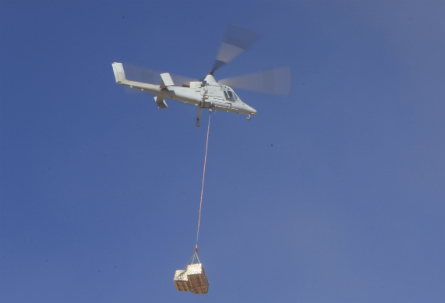The Lockheed Martin/Kaman unmanned K-Max has made its first operational flights in Afghanistan, resupplying US Marine Corps troops with cargo.
Tasked by personnel from the Marine Unmanned Aerial Vehicle Squadron 1, the unmanned vertical take-off and landing aircraft transferred roughly 1,590kg (3,500lb) of food and supplies from Camp Dwyer to troops at Combat Outpost Payne on 17 December, completing the mission in about 90min, the USMC said.
Its three pallets of supplies would ordinarily have been transferred by road convoy, added the service, which is performing a six-month assessment of the K-Max in Afghanistan before deciding whether to acquire production systems.
 |
|---|
© US Marine Corps |
The aircraft are deployed on an evaluation basis. "With every flight in theatre we are collecting data, and at the end of the day we are going to look at all of that data and decide whether or not to make it a programme of record," said Maj Kyle O’Connor, the Marine officer in charge of the detachment.
Afghanistan has served as an advanced testing ground for a substantial number of developmental systems, including a US Navy deployment of the unmanned Northrop Grumman MQ-8B Fire Scout for reconnaissance missions. A similar system, the Boeing A160, will deploy to the area in 2012.
Unlike the Northrop and Boeing offerings, the Lockheed/Kaman aircraft will be used exclusively for resupply missions to remote forward operating bases (FOB) and combat outposts. Resupply is among the most hazardous and expensive of the routine missions performed by US forces and private contractors, and demand for aerial resupply is high.
 |
|---|
© US Marine Corps |
"It's going to provide a tremendous utility to the USMC and ultimately save lives," said Lockheed. Most missions will be flown at night and over mountainous terrain. "The aircraft have infrared lighting that allows operators to see them, but do not need any unique equipment to facilitate night missions." Test missions were reportedly flown on 15 and 16 December without cargo. Both contractor and military personnel are operating the aircraft. "The deploying team consists of active duty mission commanders, air vehicle operators, and a team from Lockheed Martin. So the Marines oversee mission planning, flight conduct, air and space deconfliction. They're also at the FOBs as surrogate air vehicle operators."
The aircraft was selected for deployment after a September quick reaction assessment.
Source: Flight International


























